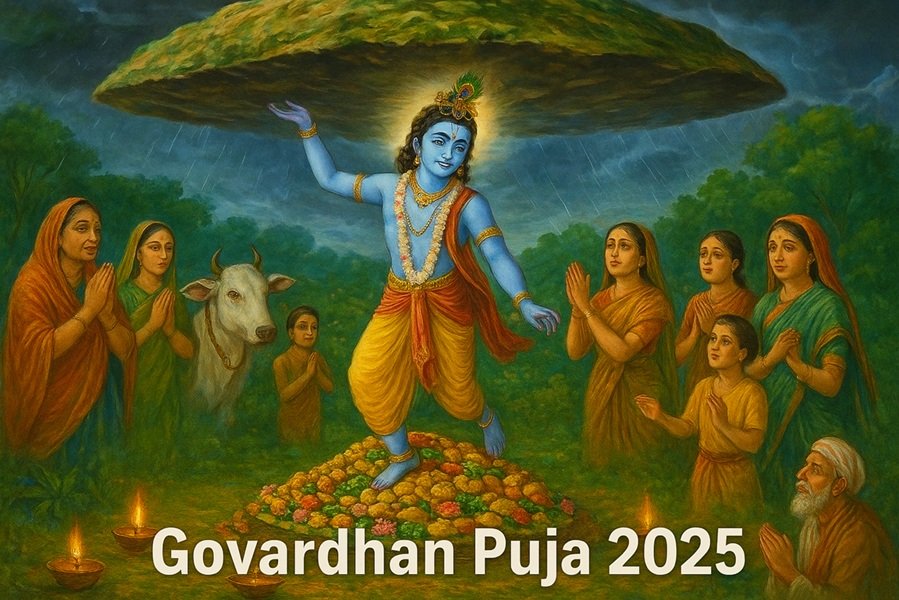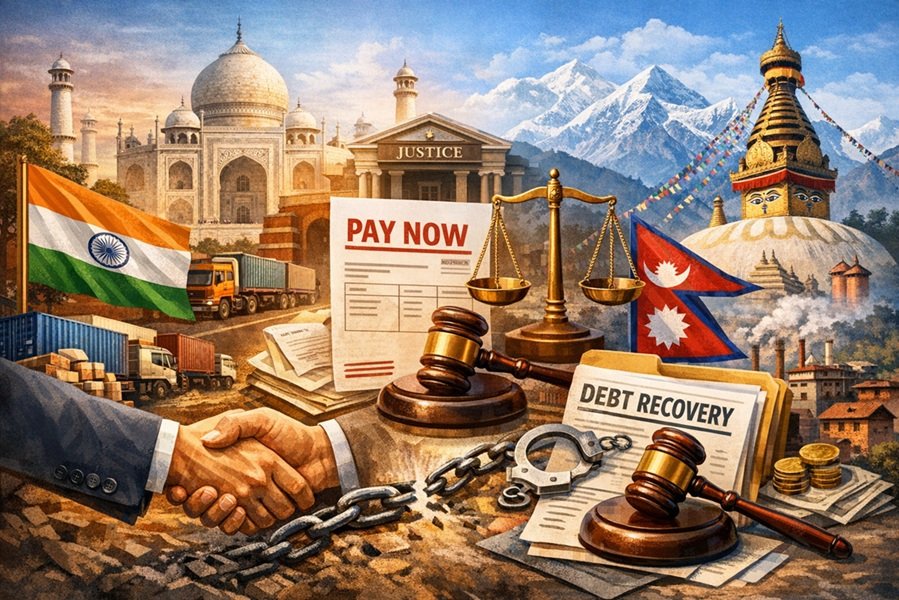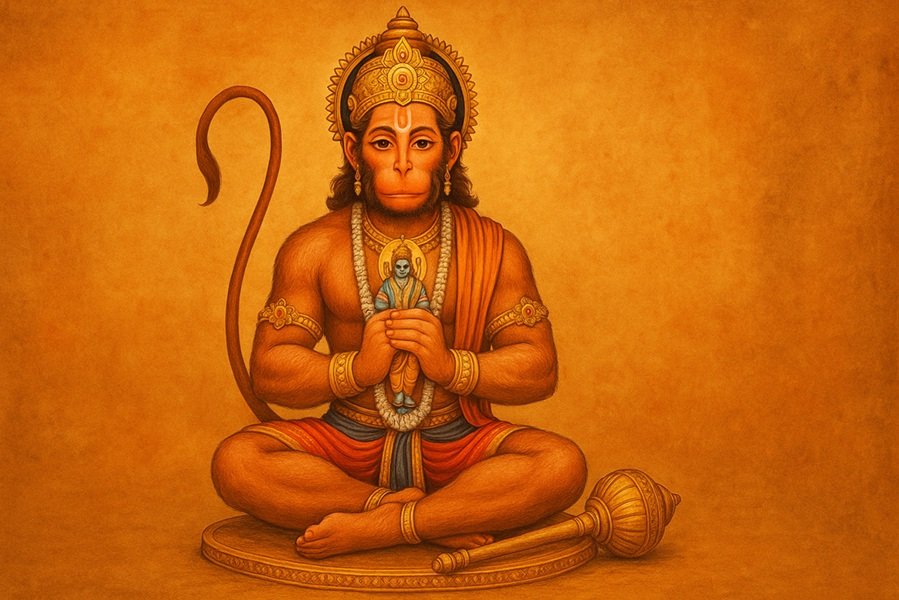
Govardhan Puja on Wednesday, October 22, 2025
Pratahkala Muhurat: 06:15 AM to 08:31 AM (Duration: 2 Hours 16 Minutes)
Sayankala Muhurat: 03:18 PM to 05:34 PM (Duration: 2 Hours 16 Minutes)
Dyuta Krida: Wednesday, October 22, 2025
Pratipada Tithi Begins: 05:54 PM on October 21, 2025
Pratipada Tithi Ends: 08:16 PM on October 22, 2025
time According to new Delhi. for more info visit https://www.drikpanchang.com/festivals/govardhan-puja/govardhan-puja-date-time.html?year=2025
Introduction
Govardhan Puja, also known as Annakut Puja, is one of the most sacred Hindu festivals celebrated a day after Diwali. In 2025, Govardhan Puja falls on Wednesday, October 22, marking the first lunar day of the Shukla Paksha in Kartik month.
The festival commemorates Lord Krishna’s divine act of lifting the Govardhan Hill to protect the residents of Vrindavan from torrential rains sent by Lord Indra. Devotees worship Govardhan Hill and cows, prepare food offerings, and express gratitude to nature for its bounty.
Govardhan Puja 2025 Date and Timings
The rituals of Govardhan Puja should ideally be performed during Pratahkala (morning) or Sayankala (evening) muhurat.
- Govardhan Puja Pratahkala Muhurat: 06:15 AM – 08:31 AM
- Duration: 2 Hours 16 Minutes
- Govardhan Puja Sayankala Muhurat: 03:18 PM – 05:34 PM
- Duration: 2 Hours 16 Minutes
- Dyuta Krida (Sacred Game of Dice): Wednesday, October 22, 2025
- Pratipada Tithi Begins: 05:54 PM on October 21, 2025
- Pratipada Tithi Ends: 08:16 PM on October 22, 2025
According to Hindu Panchang, Govardhan Puja should be performed during Pratipada Tithi unless it overlaps with Amavasya, in which case it may coincide with Diwali celebrations.
Significance of Govardhan Puja
1. Symbol of Nature Worship
Govardhan Puja is a reminder that nature sustains all living beings. The Govardhan Hill, cows, and farmlands are considered sacred because they provide food, shelter, and ecological balance.
2. Lord Krishna’s Victory Over Ego
The festival celebrates the victory of Lord Krishna over Lord Indra’s arrogance. When Indra punished Vrindavan with heavy rains, Krishna lifted the Govardhan Hill on his little finger for seven days, symbolizing humility and divine protection.
3. Gratitude to Cows and the Earth
Cows are revered as sacred, symbolizing abundance and nourishment. People clean and decorate cows, offer them prayers, and feed them as part of Go-Puja or Gau-Puja.
4. Importance of Annakut
The word Annakut means “mountain of food.” Devotees prepare a vast variety of dishes and sweets as offerings to Lord Krishna, representing devotion and gratitude for nature’s abundance.
Rituals and Traditions of Govardhan Puja
1. Preparation and Decoration
Devotees clean their homes and courtyards early in the morning. A symbolic Govardhan Hill is made from cow dung, decorated with flowers, clay figures, and colorful rangoli. Small idols representing Krishna, cows, and villagers are placed around the hill.
2. Govardhan Puja Vidhi
During the auspicious muhurat, devotees perform puja by offering flowers, incense, water, sweets, and a variety of food items (bhog) to the symbolic hill. 108 types of food may be prepared to honor Lord Krishna.
3. Annakut Offering
The Annakut is a grand display of food — including rice, sweets, fruits, and vegetables — symbolizing gratitude for prosperity. Later, the food is distributed as prasadam among family and community members.
4. Gau Puja (Cow Worship)
Cows are bathed, their horns are painted, and garlands are placed around their necks. Devotees feed cows with jaggery, rice, and green grass as a form of reverence.
5. Dyuta Krida (Sacred Game of Dice)
Dyuta Krida, or the traditional game of dice, is also associated with Govardhan Puja day. It is said that Goddess Parvati played dice with Lord Shiva on this day. Families in some regions engage in friendly dice games as a symbolic reminder of destiny and karma.
Regional Names and Observances
- In North India, the day is widely celebrated as Govardhan Puja or Annakut.
- In Gujarat, it coincides with the Gujarati New Year (Bestu Varas).
- In Maharashtra, it is observed as Bali Pratipada, celebrating King Bali’s return to Earth.
- In South India, devotees may perform Vishwakarma Puja or Kartik Pratipada rituals on this day.
Spiritual Meaning of Govardhan Puja
The essence of this festival lies in recognizing the divine in every aspect of nature. It teaches humanity to live harmoniously with the environment and emphasizes that God resides in simplicity, humility, and balance — not in arrogance or dominance.
Celebration in Temples and Communities
Major Krishna temples such as Dwarkadhish Temple (Dwarka), Banke Bihari Temple (Vrindavan), ISKCON temples worldwide, and Mathura temples hold grand Annakut ceremonies where thousands of devotees offer food to Lord Krishna.
The Govardhan Hill in Braj (Uttar Pradesh) becomes a pilgrimage site where lakhs of devotees perform Govardhan Parikrama, a 21-kilometer circumambulation around the sacred hill.
Govardhan Parikrama Ritual
The Govardhan Parikrama is a revered act of devotion where pilgrims walk barefoot around the Govardhan Hill chanting “Govardhan Giriraj Ki Jai.”
The ritual represents surrender to divine will and gratitude toward nature’s gifts. Devotees often visit holy spots like Radha Kund, Mansi Ganga, and Govinda Kund during the parikrama.
Mantra for Govardhan Puja
ॐ नमो गोवर्धनधराय श्रीकृष्णाय नमः।
Om Namo Govardhanadharaya Shri Krishnaya Namah
Chanting this mantra during puja brings peace, prosperity, and protection from negative forces.
Eco-Friendly Message of Govardhan Puja
Govardhan Puja also aligns with the principles of environmental sustainability. Worshipping cow dung (a biodegradable material) and natural resources is symbolic of an eco-conscious lifestyle — encouraging people to protect the environment just as Krishna protected Vrindavan.
Conclusion
Govardhan Puja 2025, on Wednesday, October 22, is not just a ritualistic festival but a reminder of humanity’s eternal bond with nature and divinity. By performing puja during the auspicious Pratahkala (06:15 AM – 08:31 AM) or Sayankala (03:18 PM – 05:34 PM) muhurat, devotees honor Lord Krishna’s teachings of humility, gratitude, and balance.
As the lights of Diwali fade, Govardhan Puja illuminates our path toward spiritual harmony and ecological respect.






